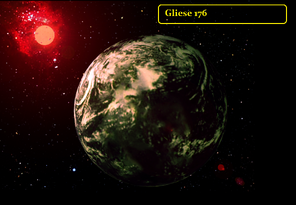
Gliese 176
UAE: красный (Russian Red)
Russian Red is a Union Star system with fourteen planets, one of which is a so called Super Earth , planet Sara Seager . The world and all planets are colonized and utilized.
For Union System info see: Russian Red, system
Epoch J2000.0 Equinox J2000.0
Constellation Taurus
Right ascension 04h 42m 55.7749s
Declination +18° 57′ 29.399″
Apparent magnitude (V) 9.95
Characteristics
Spectral type M2V
B−V color index 1.523 ± 0.025
Variable type BY Dra
Astrometry
Radial velocity (Rv) 26.4105 ± 0.0004 km/s
Proper motion (μ) RA: 656.744±0.166 mas/yr
Dec.: −1116.790±0.104 mas/yr
Parallax (π) 106.32 ± 0.60 mas
Distance 30.7 ± 0.2 ly
(9.41 ± 0.05 pc)
Absolute magnitude (MV) 10.10 ± 0.06
Details
Mass 0.50 ± 0.03 M☉
Radius 0.4525±0.0221 R☉
Luminosity 0.0337±0.0018 L☉
Temperature 3679±77 K
Metallicity [Fe/H] –0.1 ± 0.2 dex
Rotation 40.00 ± 0.11 days
Rotational velocity (v sin i) ≤0.8 km/s
Age 0.56 Gyr
Other designations
BD+18° 683, HD 285968, HIP 21932, Ross 33
Database references
SIMBAD data
Extrasolar Planets
Encyclopaedia data
Pre Astro
Gliese 176 is a red dwarf in the constellation of Taurus. Based upon parallax measurements from the Hipparcos mission, it is located approximately 30 light-years away.[1] The star is orbited by a Super-Earth.
Planetary system
A planetary companion to Gliese 176 was announced in 2008.[6] Radial velocity observations with the Hobby-Eberly Telescope (HET) showed a 10.24-day periodicity, which was interpreted as being caused by a planet. With a semi-amplitude of 11.6 m/s, its minimum mass equated to 24.5 Earth masses, or approximately 1.4 Neptune masses.
Observations with the HARPS spectrograph could not confirm the 10.24-day variation.[2] Instead, two other periodicities were detected at 8.78 and 40.0 days, with amplitudes below the HET observational errors. The 40-day variation coincides with the rotational period of the star and is therefore caused by activity, but the shorter-period variation is not explained by activity and is therefore caused by a planet. Its semi-amplitude of 4.1 m/s corresponds to a minimum mass of 8.4 Earth masses, making the planet a Super-Earth.
In an independent study, observations with Keck-HIRES also failed to confirm the 10.24-day signal.[7] An 8.77-day periodicity - corresponding to the planet announced by the HARPS team - was detected to intermediate significance, though it was not deemed significant enough to claim a planetary cause with their data alone.